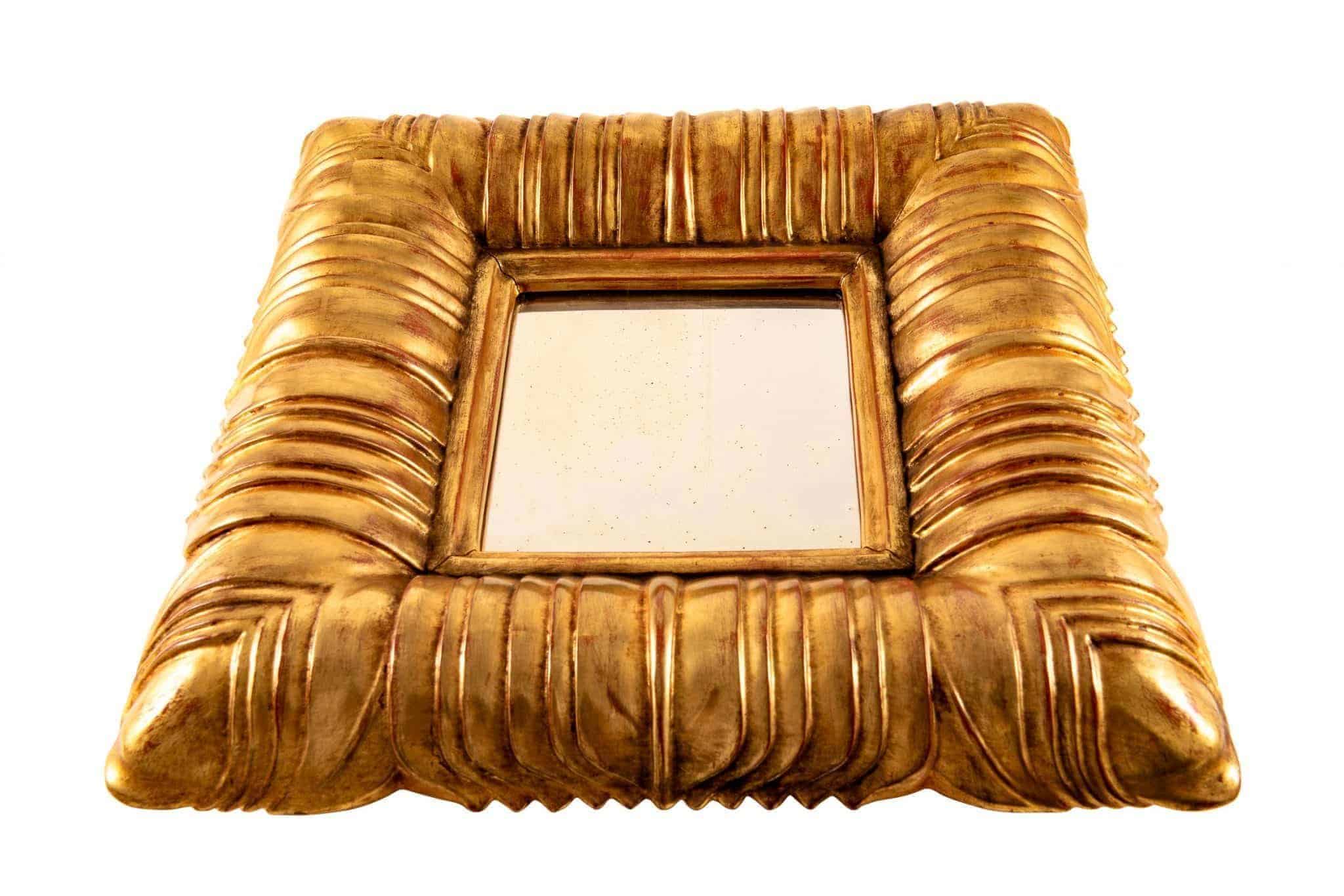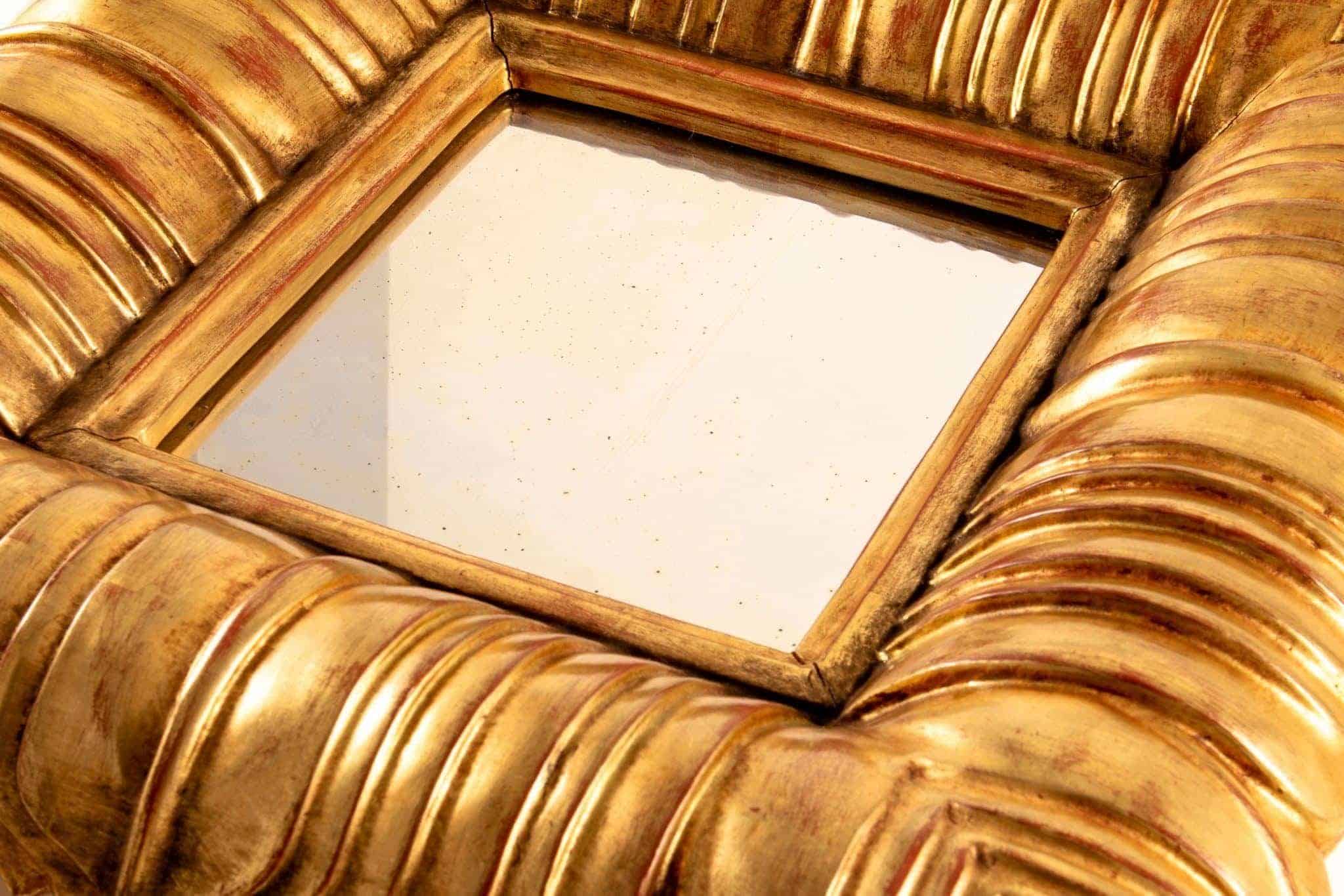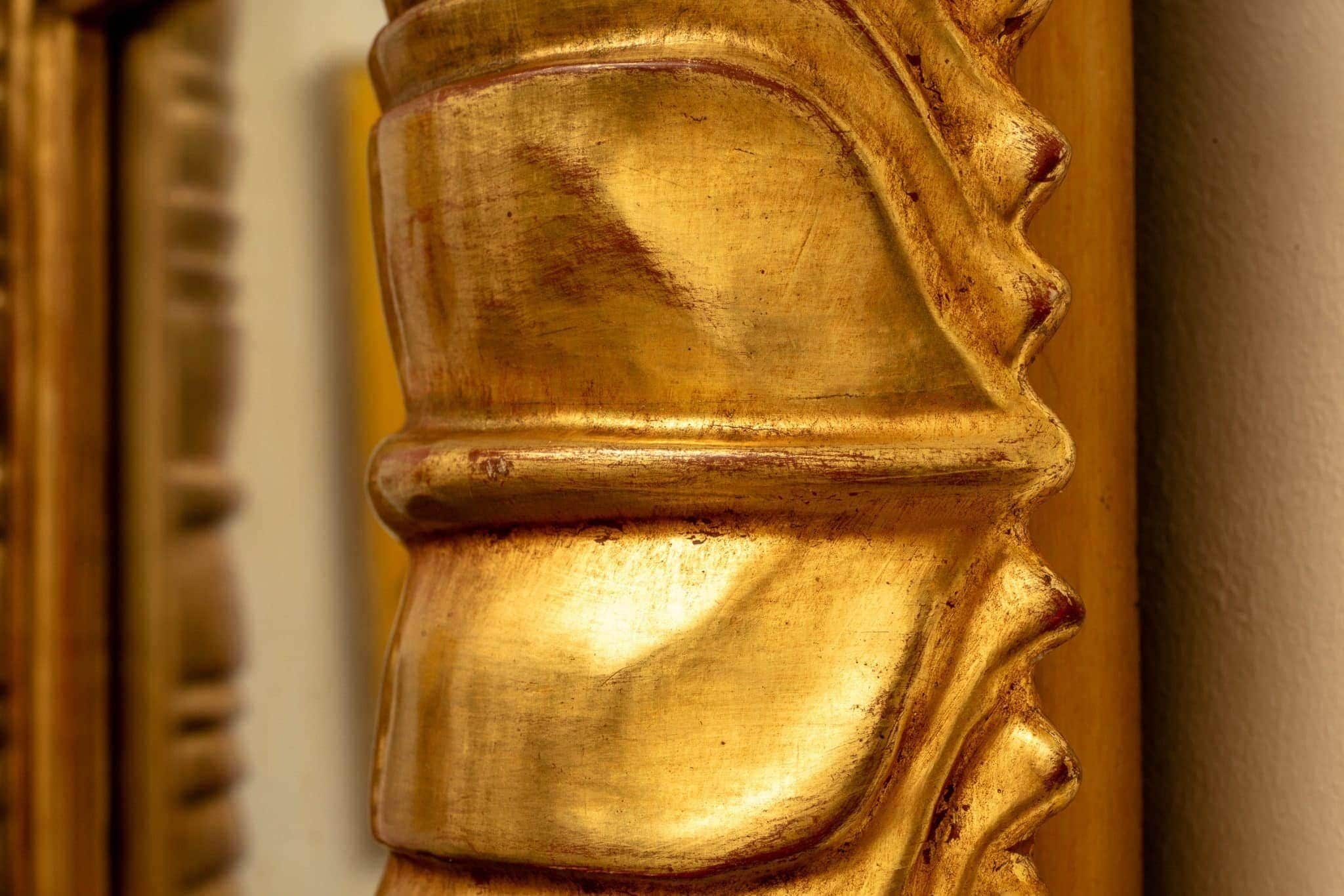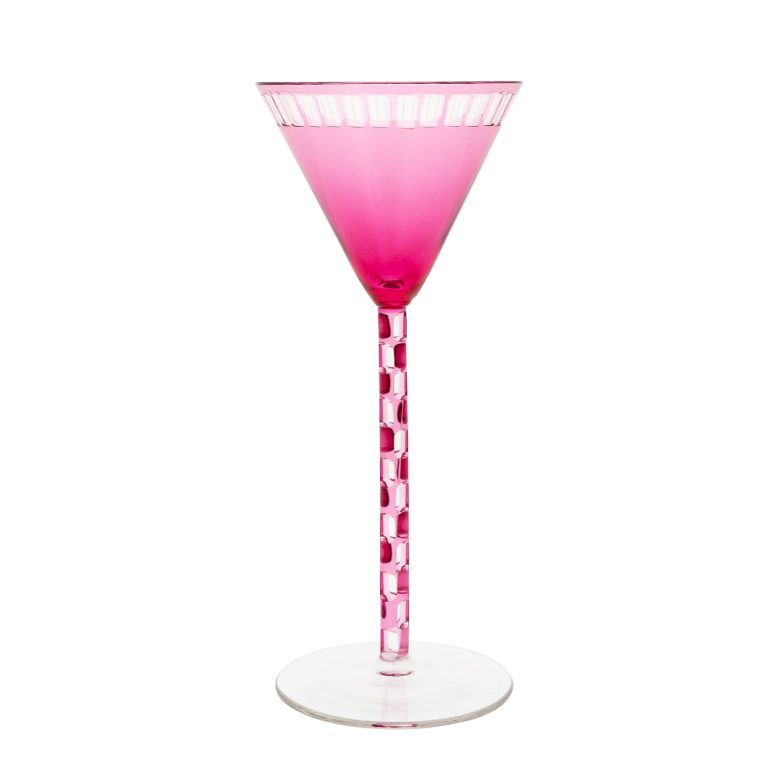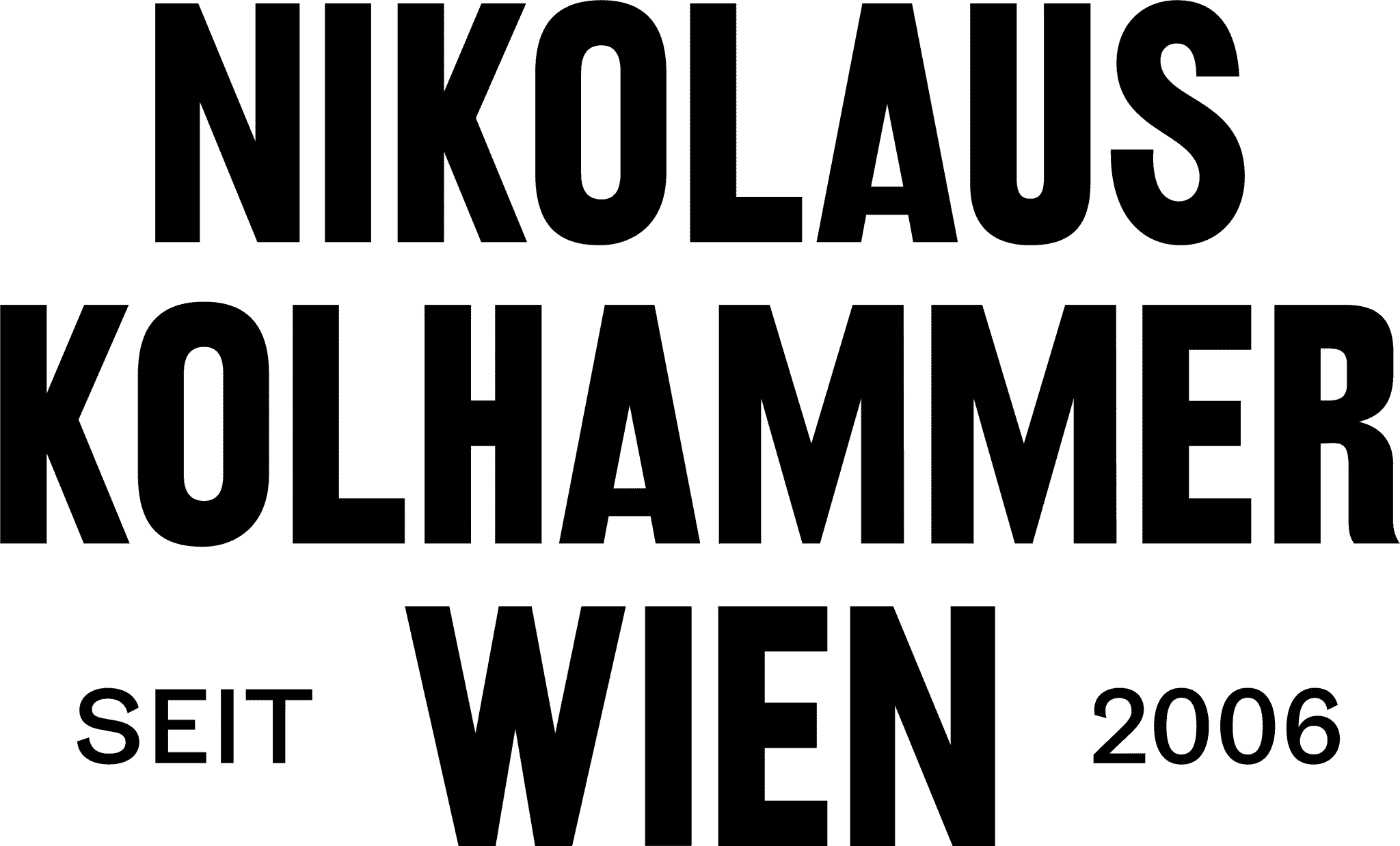Mirror Dagobert Peche Wiener Werkstatte ca. 1922
Mirror frame, designed by Dagobert Peche, executed by Max Welz for Wiener Werkstatte, ca. 1922, limewood carved and gildt
Description
“Dagobert Peche was the greatest ornamental genius to appear in Austria since the Baroque” Josef Hoffmann once paid tribute to Dagobert Peche.
As a design classic of the Wiener Werkstatte, this mirror testifies to Peche’s ingenuity. It is a symbiosis of simplicity and opulence. The square mirror is simple in its shape, while its frame is opulent. Peche lavishly decorates the mirror with vegetal decor in the form of stylized palm leaves. Carved from lime wood and still bearing the original guilding, the leaves harmonically wrap around the original lead-glass mirror.
Foliage was a central motif of Viennese Modernism and many artists captured nature’s rich ornamental language in their designs. With this mirror, Peche masterfully succeeds translating nature into artistic form. Thus, making it one of his most important and timeless mirror designs.
Designed in 1922 for the Wiener Werkstatte, the mirror was manufactured by the renowned frame manufacturer Max Welz in Vienna, which at the time had an exclusive contract with the Wiener Werkstatte. Peche’s extravagant mirrors were sold in the shops of Wiener Werkstatte, whether at the Viennese headquarter or in its branches in Zurich, Berlin or New York, and thus reached an international clientele.
Artist
Dagobert Peche (St. Michael im Lungau 1887 – 1923 Vienna)was a versatile artist whose name is mainly associated with the ornamental phase of the Wiener Werkstätte from 1915 onwards. Peche was born in 1887 in St. Michael in Lungau (Austria) and studied in Vienna from 1906 to 1911 at the Technical University and at the Academy of Fine Arts. Subsequently, the publisher Alexander Koch proved to be an important mentor, who recognized Peche's talent as an ornamentalist at a very early age and enabled him to publish in his magazine "Kunst und Dekoration". After Peche had already been creating textile designs for the fabric department of the Wiener Werkstätte since around 1911, he was officially invited by Josef Hoffmann to work as an artist in the WW in 1915. There, thanks to his inexhaustible imagination, he became one of the most important sources of inspiration for all areas of craftsmanship. Many works of the Wiener Werkstätte would probably not be conceivable without his influence. From 1917 to 1919, he managed the Zurich branch of the Wiener Werkstätte. In 1920, when the Zurich Branch closed, he returned to the company headquarters in Vienna. Peche supplied designs for wallpapers as well as fabric and designed objects in all sections of the Wiener Werkstätte, that is furniture, goldsmithing, ivory carving, mirror frames or metal goods. One of Peche's characteristics is the playful ornamental richness that seems to take the respective objects away from their purpose. Contrary to the strict lines of J. Hoffmann and K. Moser in the early days of the Wiener Werkstätte, the second decade under Peche's influence is characterized by playful, imaginative and floral ornamentation. The design genius Dagobert Peche died in 1923 in Vienna, barely 36 years old.
Execution
Wiener Werkstatte 1903 - 1932 The Wiener Werkstatte was a production community founded on the model of the Arts and Crafts movement, which aimed to provide a platform for artistically designed and high quality crafts. Or, as G. Fahr-Becker puts it "...it was a workshop that gathered many, a work of art as the result of all the arts." Founded in 1903 by Josef Hoffmann, Koloman Moser and industrialist Fritz Waerndorfer, the Wiener Werkstatte (WW) initially produced and distributed only metal objects. The range was subsequently rapidly expanded to include furniture, furnishings, textiles, jewellery, accessories made of ceramics and glass, leather, etc. The wide range of products was sold in the company's own business premises in Vienna and, for a time, also in branches in Zurich and New York. The founding fathers and artistic directors J. Hoffmann and K. Moser originally pursued the ideal of artistic penetration of all areas of life in the sense of the Gesamtkunstwerk (total work of art). This radical aspiration could only be realized in a few projects, which were commissioned primarily by upper-class patrons. Impressive examples of this are the Palais Stoclet in Brussels or the Villa Skywa-Primavesi in Vienna. In its early years, the company was still committed to a strict geometric style, but this functionalism was soon expanded to include more pleasing forms. As a representative of a more decorative line, we should mention Dagobert Peche, who with his playful, imaginative ornamentation contributed designs for all divisions of WW. An important creative contribution, especially in the decorative sections of the WW, was made by the female artists from around 1915. The best known would probably be the ceramic artists Vally Wieselthier and Gudrun Baudisch. The significance of many of these female designers has only been duly appreciated in recent years*. The increasingly difficult economic environment after World War I led to the liquidation of the WW in 1932. Gabriele Fahr-Becker writes: "The financial difficulties which the Wiener Werkstatte had to face during its existence were not primarily the result of economic ignorance, but were based on the fact that the broad public could not be reached as buyers" (G. Fahr-Becker, Wiener Werkstätte, Taschen 1994, p. 12). Beyond the relatively short period of its existence, the Wiener Werkstatte exerted a lasting influence. Arts and crafts as well as applied arts were decisively revalued and a whole generation of architects, artists and designers were influenced by the artistic will of their founding fathers. *Bib.: C. Thun-Hohenstein, A.-K. Rossberg, E. Schmuttermeier (ed.), Die Frauen der Wiener Werkstatte (The Women of the Wiener Werkstatte), exhibition catalog Museum of Applied Arts Vienna, Wien 2020
Inquiry
By submitting the inquiry form, you agree to the use of your data for this inquiry. Privacy Policy




